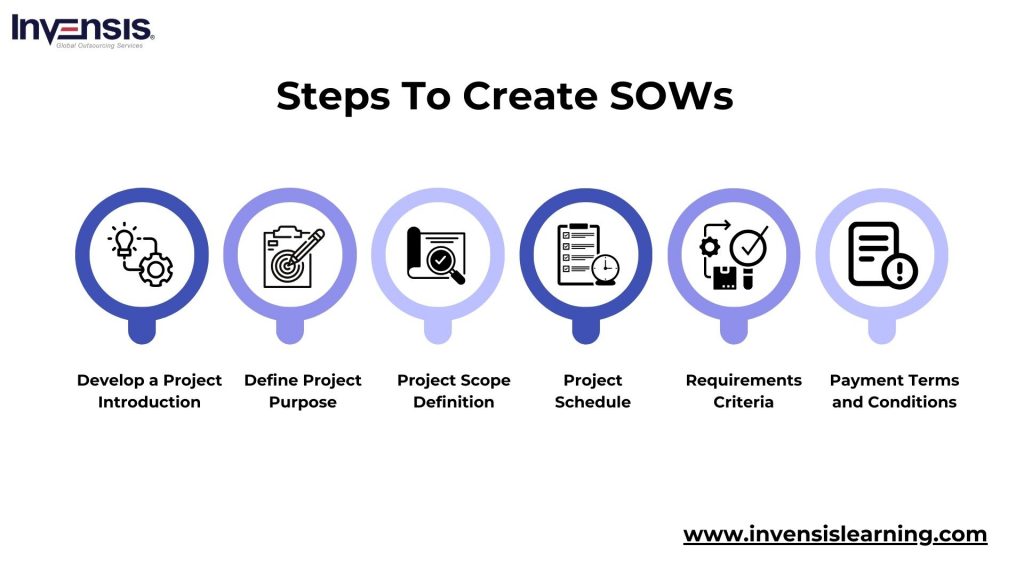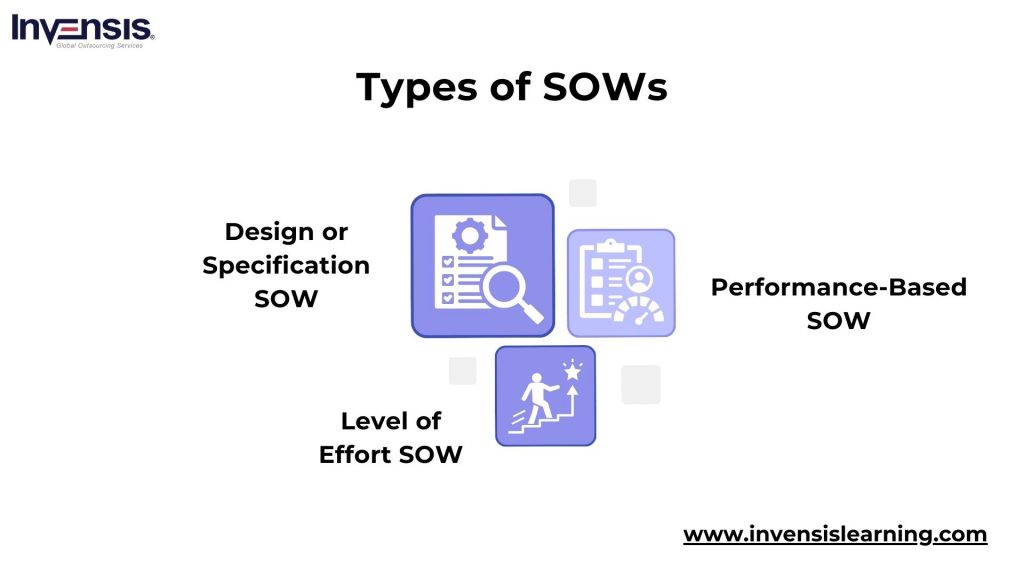
Introduction
In project management, clarity and precision are important, and the Statement of Work (SOW) serves as a foundational document that outlines the project’s objectives, deliverables, and expectations. But what exactly is an SOW, and why is it necessary in project management?
This comprehensive guide aims to explain the complexities of the SOW, providing professionals with the expertise required to utilize this vital tool in project management effectively, fostering confidence and proficiency.
However, understanding the concepts of the SOW—from its components and creation process to its various types and benefits—is essential for project managers to guide projects toward success.
Table Of Content
- What is a Statement of Work (SOW)?
- Components of a Statement of Work
- How to Create SOWs?
- Types of SOWs
- Benefits of using SOW in a project
- Statement of Work vs. Scope of Work
- Conclusion
What is a Statement of Work (SOW)?
A Statement of Work (SOW) is a crucial document in project management that outlines the key details and expectations for a project. It typically includes information such as project objectives, scope, deliverables, timelines, resources, and responsibilities of the client and the project team.
The SOW acts as a roadmap for everyone involved in the project, ensuring everyone understands what needs to be done, how it will be done, and by when. It serves as a formal agreement between the client and the project team, setting clear expectations and minimizing misunderstandings throughout the project lifecycle.
Components of a Statement of Work
A Statement of Work (SOW) is a critical document in project management that outlines the scope, objectives, deliverables, timelines, and other important aspects of a project.
The components of a Statement of Work can vary depending on the project’s complexity and requirements, but generally, it includes the following key elements:
-
Objectives
Clearly articulate the project’s objectives, detailing the purpose and desired outcomes. Objectives should be specific, measurable, achievable, relevant, and time-bound (SMART) to facilitate a clear understanding and evaluation of project success.
-
Scope of Work
Define the scope of work, outlining the tasks and responsibilities of both parties involved in the project. This section should specify what work will be performed, who will be responsible for it, and the methodologies and processes that will be utilized. Include any tools, resources, or technologies required for project execution and specify reporting mechanisms for tracking progress and communicating updates.
-
Milestones
Incorporate milestones into the Statement of Work to mark significant points of progress or achievement throughout the project lifecycle. Milestones provide clear checkpoints for evaluating progress and ensuring alignment between project expectations and delivery timelines. Payment terms may also be tied to the completion of these milestones.
-
Timelines
Provide an estimated timeline for the project duration, outlining when each milestone, deliverable, and associated payment is expected. Timelines should be flexible to accommodate changes but may include specific dates or span a range of dates to allow for adaptability.
-
Costs
Detail the overall project costs, including breakdowns for different project phases and itemized expenses such as equipment, staffing, travel, and other relevant expenditures. Specify payment terms, including the frequency and method of payment, to ensure mutual understanding and agreement between parties.
-
Signatures
Both parties should sign and date the Statement of Work document to signify their agreement with the terms and conditions outlined. Signatures confirm mutual understanding and commitment to fulfilling the obligations outlined in the document.
How to Create SOWs?
Creating Statements of Work (SOWs) is a crucial aspect of project management, as they serve as foundational documents that outline the scope, purpose, and other essential elements of a project.
Here’s a step-by-step guide on how to create SOWs:
- Develop a Project Introduction: Begin by creating a brief introduction to the project, providing an overview of its purpose and objectives. This sets the context for the rest of the document
- Define Project Purpose: Clearly define the purpose and goals of the project. Specify what the project aims to achieve and the problem it intends to solve
- Project Scope Definition: Define the project scope, outlining the boundaries and limitations of the work to be performed. Be specific about what is included in the scope and what is excluded
- Project Schedule: Develop a project schedule that outlines the timeline for completing each task, milestone, and deliverable. Ensure that the schedule is realistic and achievable
- Project Requirements and Acceptance Criteria: Define the project requirements and acceptance criteria that must be met for deliverables to be accepted. This ensures clarity on project expectations and quality standards
- Payment Terms and Conditions: Specify the payment terms and conditions for the project, including payment milestones and methods. Clearly outline the payment schedule and any penalties for late payments
By following these steps, you can create a comprehensive and well-written Statement of Work that mitigates risks, clarifies expectations, and ensures successful project execution.
Types of SOWs
In project management, several types of Statements of Work (SOWs) are tailored to specific project needs and requirements.
The three main types of statement of work agreements include design, level of effort, and performance-based SOWs.
-
Design or Specification SOW
This category of SOW provides detailed specifications and requirements necessary to complete a project. It instructs the supplier on how to execute the work and which processes to adhere to. Additionally, it outlines any specific industry regulations or standards that must be followed. The organization using this type of SOW typically assumes most of the project’s risk.
-
Level of Effort SOW
A Level of Effort SOW is employed for service-based projects. It outlines the expected work hours and materials needed to perform the service over a specific timeframe. This type of SOW provides a general framework for service delivery without specifying detailed tasks or deliverables. This SOW is preferred when the expected outcome from the project may change over time. It offers flexibility in terms of resources allocation.
-
Performance-Based SOW
A Performance-Based SOW clearly defines the project’s objectives, allocated resources, and expected deliverables without prescribing the specific methods or processes for achieving them. This type of SOW offers flexibility, focuses on project outcomes, and distributes risk between parties. It is often preferred by companies due to its adaptability and emphasis on results rather than methods.
Benefits of using SOW in a project
A Statement of Work is an investment in project success. By taking the time to create a clear and comprehensive SOW, project managers can set the stage for smoother execution, better communication, and, ultimately, a higher chance of achieving project goals on time and within budget. Utilizing SOW in a project offers numerous benefits:
- Improves Clarity and Understanding: Ensures all understand the project scope, objectives, and timeline, avoiding misunderstandings
- Risk Mitigation: Identifies risks upfront, enabling proactive management and reducing impact on project success
- Achieves Common Objectives: Serves as a roadmap, aligning efforts towards desired outcomes
- Manages Expectations: Defines roles and timelines clearly, reducing dissatisfaction and misunderstandings
- Protects the Project Team: Acts as a contractual agreement, reducing disputes and providing legal documentation
- Attracts and Retains Clients: Inspires client confidence by showcasing your team’s ability to plan, organize, and deliver successful projects
Statement of Work vs. Scope of Work
| Aspect | Statement of Work (SOW) | Scope of Work (SoW) |
| Definition | A comprehensive document outlining the entire project details | Subset of SOW, focusing on specific tasks and deliverables |
| Contents | Includes project objectives, deliverables, timelines, milestones, etc. | Details specific tasks, activities, and deliverables within the project scope |
| Purpose | Formal agreement between client and project team/service provider | Defines boundaries of project scope, prevents scope creep |
| Focus | Provides overview of the entire project | Specific focus on work to be performed |
| Contractual Aspects | Outlines terms and conditions of the project | Helps prevent misunderstandings, clarifies project boundaries |
Conclusion
The Statement of Work (SOW) is a fundamental document in project management, serving as a comprehensive blueprint that outlines the scope, objectives, deliverables, timelines, and other essential details of a project. By providing clarity, defining expectations, and establishing a contractual agreement between the client and the project team or service provider, the SOW plays a crucial role in ensuring successful project execution.
Its planning and detailed specifications help mitigate risks, manage expectations, and facilitate effective communication, ultimately contributing to achieving project goals and client satisfaction.
Do you want to write a clear, effective SOW? We can help you achieve that! Invensis Learning offers different Project Management Certification Courses and training programs to equip you with the knowledge and expertise you need to excel.

















